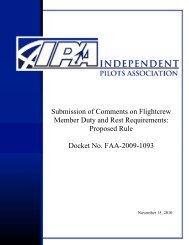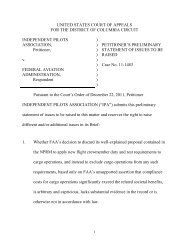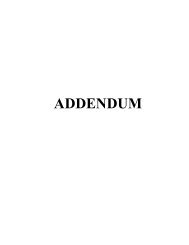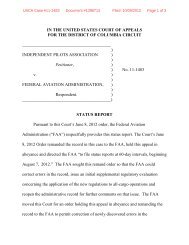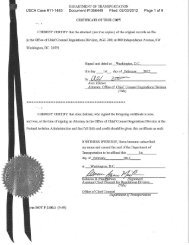Exhibits Vol 2 - Independent Pilots Association
Exhibits Vol 2 - Independent Pilots Association
Exhibits Vol 2 - Independent Pilots Association
You also want an ePaper? Increase the reach of your titles
YUMPU automatically turns print PDFs into web optimized ePapers that Google loves.
xi<br />
Aircraft Accident Report<br />
Executive Summary<br />
On November 12, 2001, about 0916:15 eastern standard time, American Airlines<br />
flight 587, an Airbus Industrie A300-605R, N14053, crashed into a residential area of<br />
Belle Harbor, New York, shortly after takeoff from John F. Kennedy International Airport,<br />
Jamaica, New York. Flight 587 was a regularly scheduled passenger flight to Las<br />
Americas International Airport, Santo Domingo, Dominican Republic, with 2 flight<br />
crewmembers, 7 flight attendants, and 251 passengers aboard the airplane. The airplane’s<br />
vertical stabilizer and rudder separated in flight and were found in Jamaica Bay, about<br />
1 mile north of the main wreckage site. The airplane’s engines subsequently separated in<br />
flight and were found several blocks north and east of the main wreckage site. All<br />
260 people aboard the airplane and 5 people on the ground were killed, and the airplane<br />
was destroyed by impact forces and a postcrash fire. Flight 587 was operating under the<br />
provisions of 14 Code of Federal Regulations Part 121 on an instrument flight rules flight<br />
plan. Visual meteorological conditions prevailed at the time of the accident.<br />
The National Transportation Safety Board determines that the probable cause of<br />
this accident was the in-flight separation of the vertical stabilizer as a result of the loads<br />
beyond ultimate design that were created by the first officer’s unnecessary and excessive<br />
rudder pedal inputs. Contributing to these rudder pedal inputs were characteristics of the<br />
Airbus A300-600 rudder system design and elements of the American Airlines Advanced<br />
Aircraft Maneuvering Program.<br />
The safety issues discussed in this report focus on characteristics of the A300-600<br />
rudder control system design, A300-600 rudder pedal inputs at high airspeeds,<br />
aircraft-pilot coupling, flight operations at or below an airplane’s design maneuvering<br />
speed, and upset recovery training programs. Safety recommendations concerning these<br />
issues are addressed to the Federal Aviation Administration and the Direction Général de<br />
l’Aviation Civile.



